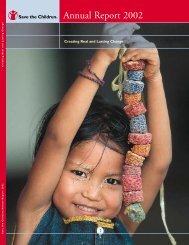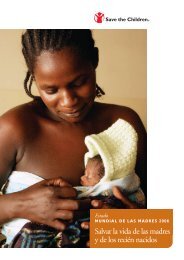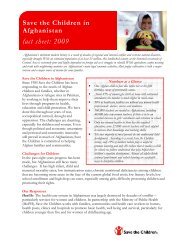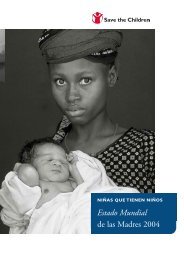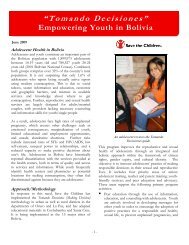The Power and Promise of Girls' Education - Save the Children
The Power and Promise of Girls' Education - Save the Children
The Power and Promise of Girls' Education - Save the Children
You also want an ePaper? Increase the reach of your titles
YUMPU automatically turns print PDFs into web optimized ePapers that Google loves.
Endnotes<br />
1<br />
35 countries will miss <strong>the</strong> 2005 Millennium Development<br />
Goal target for eliminating gender disparities in primary<br />
education; 68 countries will miss <strong>the</strong> 2005 target for<br />
eliminating gender disparities in secondary education; 27<br />
countries will miss both targets; <strong>and</strong> 76 countries will<br />
miss one, <strong>the</strong> o<strong>the</strong>r, or both. Source: UNESCO. EFA Global<br />
Monitoring Report 2003-04, Gender <strong>and</strong> <strong>Education</strong> for All:<br />
<strong>The</strong> Leap to Equality. (Paris: 2003)<br />
2<br />
UNESCO. EFA - <strong>The</strong> Quality Imperative, Global Monitoring<br />
Report 2005. (Paris: 2004)<br />
3<br />
Ibid.<br />
4<br />
Ibid.<br />
5<br />
Ibid.<br />
6<br />
UNESCO. EFA Global Monitoring Report 2003-04, Gender<br />
<strong>and</strong> <strong>Education</strong> for All:<strong>The</strong> Leap to Equality. (Paris: 2003)<br />
7<br />
UN Millennium Project,Task Force on <strong>Education</strong> <strong>and</strong><br />
Gender Equality. Toward Universal Primary <strong>Education</strong>:<br />
Investments, Incentives, <strong>and</strong> Institutions. (Earthscan:<br />
London/Sterling,VA: 2005)<br />
8<br />
Basic <strong>Education</strong> Coalition. Teach a Child,Transform a Nation<br />
(Washington: 2004) <strong>and</strong> World Bank. World Development<br />
Indicators. (Washington: 2002)<br />
9<br />
World Bank. World Development Report. (New York:<br />
Oxford University Press: 1993); C. Colclough <strong>and</strong> K.<br />
Lewin. Educating All <strong>the</strong> <strong>Children</strong>: Strategies for Primary<br />
Schooling in <strong>the</strong> South. (Clarendon Press: Oxford: 1993)<br />
<strong>and</strong> L. Summers. Investing in All <strong>the</strong> People: Educating<br />
Women in Developing Countries. Seminar Paper No.45.<br />
(World Bank Economic Development Institute: 1994)<br />
10<br />
Abu-Ghaida, D. <strong>and</strong> S. Klasen.“<strong>The</strong> Costs <strong>of</strong> Missing <strong>the</strong><br />
Millennium Development Goal on Gender Equity,” World<br />
Development,Vol. 32, No. 7. (Elsevier: Great Britain: 2004)<br />
11<br />
Abu-Ghaida <strong>and</strong> Klasen (2004) <strong>and</strong> L. Smith <strong>and</strong> L.<br />
Haddad. Overcoming Child Malnutrition in Developing<br />
Countries: Past Achievement <strong>and</strong> Future Choices, Discussion<br />
Paper No.30 (International Food Policy Research<br />
Institute: 2000) <strong>and</strong> World Bank. World Development<br />
Report (1993)<br />
12<br />
Duncan,T. Contraceptive Choice, Fertility <strong>and</strong> Public Health in<br />
Zimbabwe. LSMS Working Paper Series No.109. (World<br />
Bank: 1995)<br />
13<br />
Ibid.<br />
14<br />
Feyisetan, B. J. Contraceptive Use <strong>and</strong> <strong>the</strong> Quality, Price <strong>and</strong><br />
Availability <strong>of</strong> Family Planning in Nigeria.World Bank LSMS<br />
Working Paper Series No.108. (1994)<br />
15<br />
Abu-Ghaida <strong>and</strong> Klasen (2004) <strong>and</strong> N. Mellington <strong>and</strong><br />
L. Cameron.“Female <strong>Education</strong> <strong>and</strong> Child Mortality,”<br />
Bulletin <strong>of</strong> Indonesian Economic Studies,Vol.35, No.3. (1999)<br />
16<br />
Based on United Nations population projections for <strong>the</strong><br />
0-4 age group <strong>and</strong> current fertility rates.Abu-Ghaida &<br />
Klasen (2004)<br />
17<br />
Thomas, D.“Intrahousehold Resource Allocation:An<br />
Inferential Approach,” Journal <strong>of</strong> Human Resources,Vol.25,<br />
No.4. (1990)<br />
18<br />
Smith, L. <strong>and</strong> L. Haddad. Overcoming Child Malnutrition in<br />
Developing Countries: Past Achievement <strong>and</strong> Future Choices,<br />
Discussion Paper No.30 (International Food Policy<br />
Research Institute: 2000)<br />
19<br />
Bicego, G. <strong>and</strong> O.Ahmad, Infant <strong>and</strong> Child Mortality,<br />
Demographic <strong>and</strong> Health Surveys Comparative Studies<br />
No.20. (Macro International Inc.: Calverton, Maryl<strong>and</strong>:<br />
1996)<br />
20<br />
Basic <strong>Education</strong> Coalition, Teach a Child,Transform a<br />
Nation;World Bank. World Development Indicators, 2002<br />
<strong>and</strong> A. Gage, E. Sommerfelt <strong>and</strong> A. Piani.“Household<br />
Structure <strong>and</strong> Childhood Immunization in Niger <strong>and</strong><br />
Nigeria,” Demography,Vol.34, No.2. (1997)<br />
21<br />
Joint United Nations Programme on HIV/AIDS <strong>and</strong><br />
World Health Organization. AIDS Epidemic Update. (2003)<br />
22<br />
Where <strong>the</strong> literacy gap between boys <strong>and</strong> girls is greater<br />
than 25 percent, HIV prevalence exceeds outbreak level<br />
<strong>of</strong> 5 percent. HIV prevalence rates fall to 3 percent<br />
where <strong>the</strong> literacy gap is below 5 percent. Source: Over,<br />
Mead.“<strong>The</strong> Effects <strong>of</strong> Societal Barriers on Urban Rates <strong>of</strong><br />
HIV Infection in Developing Countries:An Explanatory<br />
Analysis” in M.Ainsworth, L. Franson <strong>and</strong> M.Overs, eds.,<br />
Confronting AIDS: Evidence from <strong>the</strong> Developing World.<br />
(European Commission <strong>and</strong> World Bank: Brussels <strong>and</strong><br />
Washington: 1998)<br />
23<br />
Joint United Nations Programme on HIV/AIDS <strong>and</strong><br />
World Health Organization. AIDS Epidemic Update (2003)<br />
24<br />
Gupta, G.R., International Center for Research on<br />
Women, http://www.icrw.org/docs/Speeches/2005_<br />
Internationalwday.pdf<br />
25<br />
de Walque, D. How Does <strong>the</strong> Impact <strong>of</strong> <strong>the</strong> HIV/AIDS<br />
Information Campaign Vary with <strong>Education</strong>al Attainment?<br />
Evidence from Rural Ug<strong>and</strong>a.World Bank Research<br />
Working Paper Series No.3289 (2004) <strong>and</strong> Basic<br />
<strong>Education</strong> Coalition, Teach a Child,Transform a Nation<br />
(2004)<br />
26<br />
V<strong>and</strong>emoortele, J. <strong>and</strong> E. Delamonica.“<strong>Education</strong> Vaccine<br />
Against HIV/AIDS,” Current Issues in Comparative<br />
<strong>Education</strong>,Vol.3, No.1. (2000)<br />
27<br />
Ibid.<br />
28<br />
Joint United Nations Programme on HIV/AIDS <strong>and</strong><br />
World Health Organization.AIDS Epidemic Update (2004)<br />
29<br />
USAID, More But Not Yet Better: USAID’s Programs <strong>and</strong><br />
Policies to Improve Girls’ <strong>Education</strong>, USAID Evaluation<br />
Highlights No.64. (June 1999)<br />
30<br />
Abu-Ghaida & Klasen (2004)<br />
31<br />
Knowles, S., P.K. Lorelly, <strong>and</strong> P.D. Owen. Are <strong>Education</strong>al<br />
Gender Gaps a Brake on Economic Development? Some<br />
Cross-Country Empirical Evidence, Oxford Economic Papers,<br />
Vol.54, No.1. (2002)<br />
32<br />
Dollar, D. <strong>and</strong> R. Gatti. Gender Inequality, Income <strong>and</strong><br />
Growth: Are Good Times Good for Women? World Bank<br />
Policy Research Paper Series No.1 (1999)<br />
33<br />
World <strong>Education</strong> Forum. A Test Case for <strong>Education</strong>.<br />
http://www2.unesco.org/wef/en-press/press-kit_asia.shtm<br />
34<br />
Barro, R.J.“Determinants <strong>of</strong> Democracy,” Journal <strong>of</strong><br />
Political Economy.Vol.107, No.6. (1999)<br />
35<br />
UNESCO. Women <strong>and</strong> Girls: <strong>Education</strong>, Not Discrimination.<br />
(New York: 2000)<br />
36<br />
USAID. Advancing Basic <strong>Education</strong> <strong>and</strong> Literacy Project.<br />
An Analysis <strong>of</strong> <strong>the</strong> Impact <strong>of</strong> Literacy on Women’s<br />
Empowerment in Nepal. (Washington: 1997)<br />
37<br />
Johnson, D. with H. Kabuchu <strong>and</strong> S.V. Kayonga. Women in<br />
Ug<strong>and</strong>an Local Government:<strong>The</strong> Impact <strong>of</strong> Affirmative Action,<br />
Gender <strong>and</strong> Development, Oxfam, www.oxfam.org.uk/<br />
what_we_do/resources/downloads/gdc_johnson.pdf<br />
38<br />
Anderlini, S.N. Women at <strong>the</strong> Peace Table: Making a<br />
Difference. (UNIFEM: New York: 2000)<br />
39<br />
Machel, G. <strong>The</strong> Impact <strong>of</strong> War on <strong>Children</strong>. (Palgrave: New<br />
York: 2001)<br />
40<br />
Afghan Women’s Bill <strong>of</strong> Rights,<br />
http://afghansforcivilsociety.org/programs/womens%20issu<br />
es/community_center/bill<strong>of</strong>rights.htm <strong>and</strong> Women in<br />
Afghanistan: Afghan Women’s Rights,<br />
http://www.pbs.org/independentlens/afghanistanunveiled/women.html<br />
41<br />
Azis, I.J.,A.F. Siddik <strong>and</strong> M. van der Boon. Promoting<br />
Democracy through Transnational <strong>and</strong> O<strong>the</strong>r <strong>Education</strong><br />
Initiatives for Women:<strong>The</strong> Case <strong>of</strong> Indonesia. Paper<br />
presented at <strong>the</strong> Asia-Europe Workshop on Transnational<br />
Business Networks,Vrije Universiteit,Amsterdam, <strong>the</strong><br />
Ne<strong>the</strong>rl<strong>and</strong>s. (2003)<br />
42<br />
UNICEF, At a Glance: Bolivia.<br />
http://www.unicef.org/infobycountry/bolivia_24068.html<br />
43<br />
Saitoti, G. Quality <strong>Education</strong> <strong>and</strong> Socio Inclusion.<br />
http://www.ibe.unesco.org/International/ICE47/English/Me<br />
sMOE/messages/kenya.html<br />
44<br />
UNESCO. Gender <strong>and</strong> <strong>Education</strong> for All: <strong>The</strong> Leap to<br />
Equality: Summary Report. (Paris: 2003) <strong>and</strong> Herz, B.<br />
“Universal Basic <strong>Education</strong>:What Works.” Paper prepared<br />
for <strong>the</strong> Coalition for Basic <strong>Education</strong> (Washington:<br />
Academy for <strong>Education</strong>al Development: 2002)<br />
45<br />
Castrol-Leal, F. Who Benefits from Public <strong>Education</strong> Spending<br />
in Malawi: Results from <strong>the</strong> Recent <strong>Education</strong> Reform.World<br />
Bank Discussion Paper, No.350. (1996) <strong>and</strong> J. Chimombo,<br />
et al. Classroom, School <strong>and</strong> Home Factors that Negatively<br />
Affect Girls <strong>Education</strong> in Malawi, a report submitted to<br />
UNICEF. (2000)<br />
46<br />
UNAIDS. Lesotho: Epidemiological Fact Sheets on HIV/AIDS<br />
<strong>and</strong> Sexually Transmitted Infections, 2004.<br />
http://www.unaids.org/EN/o<strong>the</strong>r/functionalities/Search.asp<br />
47<br />
UNICEF. <strong>The</strong> State <strong>of</strong> <strong>the</strong> World’s <strong>Children</strong> 2005 (Tables 4<br />
<strong>and</strong> 6)<br />
48<br />
Ibid.<br />
49<br />
American Association <strong>of</strong> University Women, Gender Equity<br />
in <strong>Education</strong>: Myth vs. Reality. (Washington: 2001)<br />
50<br />
Silverman, S. <strong>and</strong> A. Pritchard.“Building <strong>The</strong>ir Future: Girls<br />
<strong>and</strong> Technology <strong>Education</strong> in Connecticut,” Journal <strong>of</strong><br />
Technology <strong>Education</strong>,Vol.7, No.2. (1996)<br />
51<br />
Hanson, K. Gender, Discourse, <strong>and</strong> Technology. (Center for<br />
<strong>Education</strong>, Employment <strong>and</strong> Community at EDC:<br />
Massachusetts: 2001)<br />
52<br />
American Association <strong>of</strong> University Women (2001)<br />
53<br />
Amin, S. <strong>and</strong> M.Arends-Keunning.“School Incentive<br />
Programs <strong>and</strong> <strong>Children</strong>’s Activities:<strong>The</strong> Case <strong>of</strong> Bangladesh,”<br />
Comparative <strong>Education</strong> Review,Vol. 48, No.3. (2004)<br />
54<br />
Ibid.<br />
55<br />
Ahmend,A., O. Chowdhury <strong>and</strong> C. Del Ninno. Evaluating<br />
<strong>the</strong> Food for <strong>Education</strong> Program in Bangladesh (International<br />
Food Policy Research Institute:Washington: 2001)<br />
56<br />
World Bank. Pioneering Support for Girls’ Secondary<br />
<strong>Education</strong>: <strong>The</strong> Bangladesh Female Secondary School<br />
Assistance Project.<br />
http://lnweb18.worldbank.org/sar/sa.nsf/0/711b108cef83b<br />
b428525687b0065e37e?OpenDDocument<br />
57<br />
USAID. Global <strong>Education</strong> Database.<br />
http://qesdb.cdie.org/ged/index.html<br />
58<br />
Iqbal, F. <strong>and</strong> N. Riad. Increasing Girls’ School Enrollment in <strong>the</strong><br />
Arab Republic <strong>of</strong> Egypt. (World Bank: Social <strong>and</strong> Economic<br />
Development Department, Middle East <strong>and</strong> North Africa<br />
Region:Washington: 2004)<br />
59<br />
Iqbal & Riad (2004) <strong>and</strong> N. Ibrahim, S. Sallam, S. El Tawila<br />
<strong>and</strong> O. El Gibaly. Transitions to Adulthood: A National Survey<br />
<strong>of</strong> Egyptian Adolescents. (<strong>The</strong> Population Council: New<br />
York: 2000)<br />
60<br />
<strong>The</strong> net enrollment rate is more accurate than <strong>the</strong> gross<br />
enrollment rate in depicting <strong>the</strong> efficiency <strong>of</strong> <strong>the</strong> school<br />
system.<br />
61<br />
Iqbal & Riad (2004)<br />
62<br />
Filmer, D. <strong>The</strong> Structure <strong>of</strong> Social Disparities in <strong>Education</strong>.<br />
Policy Research Working Paper No.2268 (World Bank<br />
Development Research Group/Poverty <strong>and</strong> Human<br />
Resources:Washington: 2000)<br />
63<br />
Behrman J.,A. Foster, M. Rosenzweig <strong>and</strong> P.Vashish<strong>the</strong>.<br />
“Women’s Schooling, Home Teaching, <strong>and</strong> Economic<br />
Growth,” Journal <strong>of</strong> Political Economy,Vol.107, No.4. (1999)<br />
64<br />
Based on 2003 data derived from <strong>the</strong> statistical pr<strong>of</strong>iles<br />
for all African countries presented in UNICEF’s State <strong>of</strong><br />
<strong>the</strong> World’s <strong>Children</strong> 2005.<br />
65<br />
UNICEF. At a Glance: Benin.<br />
http://www.unicef.org/infobycountry/benin.html<br />
66<br />
Basic <strong>Education</strong> Coalition. Educated Girls: A Cornerstone <strong>of</strong><br />
Healthy Families <strong>and</strong> Societies.<br />
http://www.basiced.org/facts/girls_ed.pdf<br />
67<br />
Community Participation in Decision Making Processes: World<br />
Learning’s Experience in Guatemala <strong>and</strong> Benin. Prepared for<br />
Joshua Muskin, Senior <strong>Education</strong> Advisor, World Learning<br />
for International Development by M. Gardner Coppola,<br />
C. Luczak <strong>and</strong> M. Stephenson, May 2003.<br />
www.gwu.edu/~oid/World_Learning_Participatory.doc<br />
68<br />
USAID. Benin.<br />
http://www.usaid.gov/policy/budget/cbj2004/<br />
sub-saharan_africa/Benin.pdf<br />
69<br />
USAID. Creating an Enabling Environment for a Successful<br />
Basic <strong>Education</strong> Reform Program.<br />
http://www.usaid.gov/bj/education/p-environ.html<br />
70<br />
Based on 2003 data derived from <strong>the</strong> statistical pr<strong>of</strong>ile on<br />
Benin presented in UNICEF’s <strong>The</strong> State <strong>of</strong> <strong>the</strong> World’s<br />
<strong>Children</strong> 2005<br />
71<br />
World Bank. Bolivia Rural Scholarship Pilot.<br />
http://www.worldbank.org/education/economicsed/finance<br />
/dem<strong>and</strong>/case/bolivia/bolivia_index.htm<br />
72<br />
Ibid.<br />
73<br />
UNICEF. At a Glance: Bolivia. http://www.unicef.org/infobycountry/bolivia_statistics.html<br />
74<br />
World <strong>Education</strong>. A Longitudinal Study <strong>of</strong> <strong>the</strong> Effect <strong>of</strong><br />
Integrated Literacy <strong>and</strong> Basic <strong>Education</strong> Programs on Women’s<br />
Participation in Social <strong>and</strong> Economic Development in Bolivia.<br />
http://www.worlded.org/docs/Bolivia10_26_02FINAL.pdf<br />
44<br />
THE POWER AND PROMISE OF GIRLS’ EDUCATION




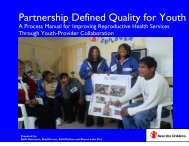

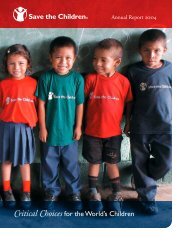
![View full document [PDF 3.39 MB] - PreventionWeb](https://img.yumpu.com/27308954/1/190x245/view-full-document-pdf-339-mb-preventionweb.jpg?quality=85)
